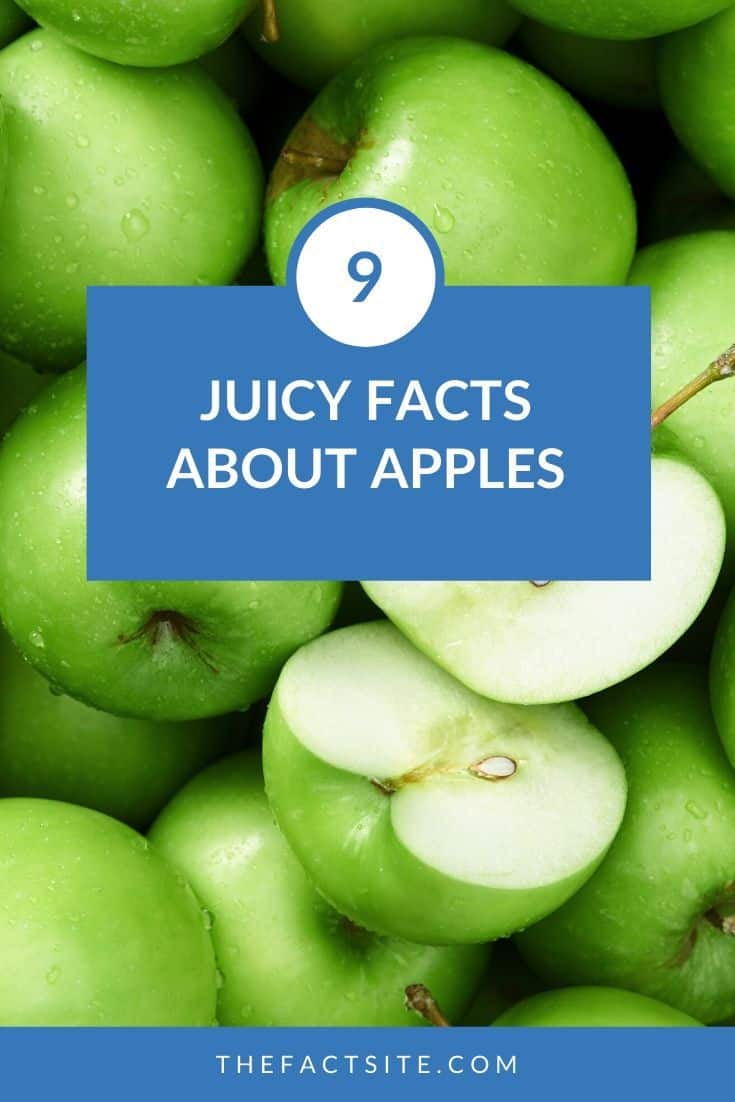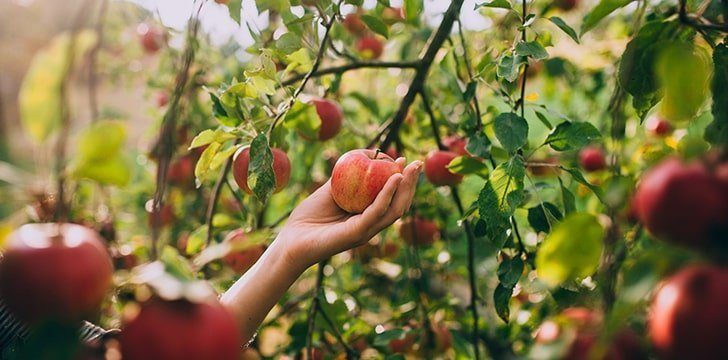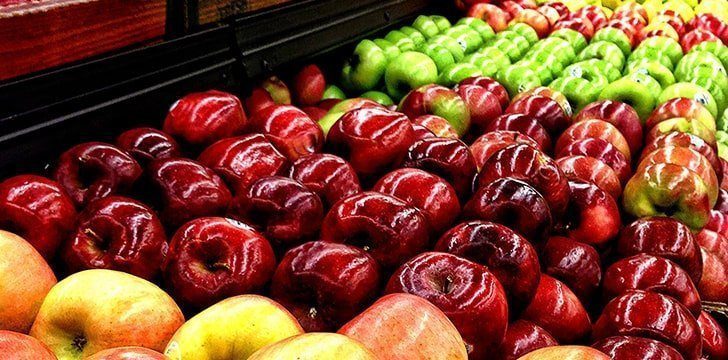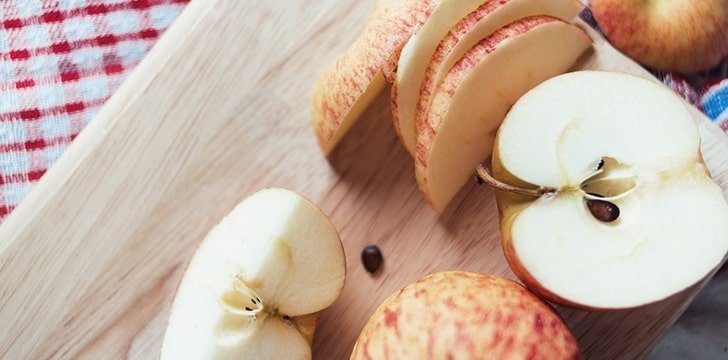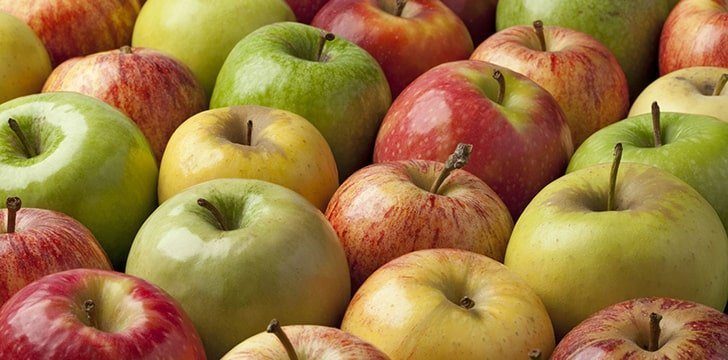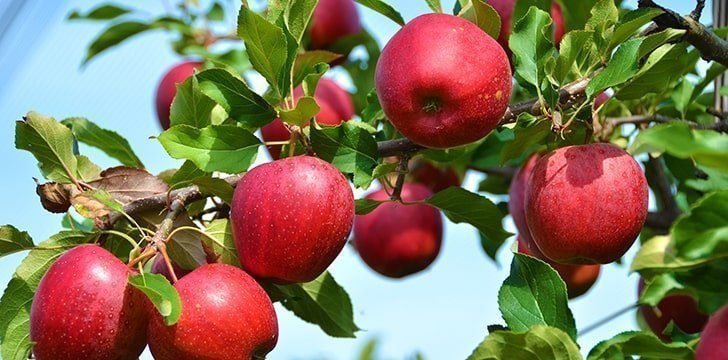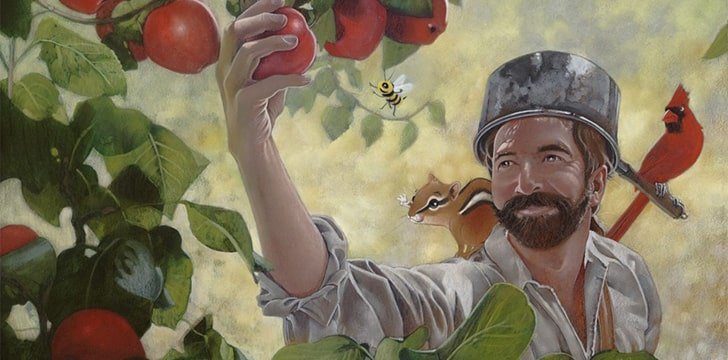- Fruits: Apple
- Скачать:
- Предварительный просмотр:
- 9 Juicy Facts About Apples
- An apple a day keeps the doctor away.
- Eve picked a forbidden fruit, but it wasn’t an apple.
- Apples are things of myths and legends.
- If you plant the seeds from an apple, it will grow into a new variety.
- There are thousands of varieties of apples.
- Apples originally came from Kazakhstan.
- Over 66 million tons of apples are produced every year.
- Cider has been brewed for over 2,000 years.
- There’s a US folk hero called Johnny Appleseed who spread apples all over the USA.
Fruits: Apple
Работа на английском языке. В данном реферате подробно рассматривается роль яблока в истории человечества. На первый взгляд может показаться, что тема не столь интересна, сколь абсурдна. Хоть яблоки и привычны для нас, в истории существует много легенд, в которых фигурируют именно яблоки. Все народы в мире почитают яблоко: существуют праздники, посвященные яблоку, люди распевают песни о яблоках, посвящают яблокам стихи, на Руси всегда был популярен танец «Яблочко», даже IT технологии производит «Apple».
В работе прослеживаются любопытные межпредметные связи: с литературой – дается краткий обзор греческих мифов и русских народных сказок; с физикой — открытие закона всемирного тяготения; с информатикой.
Скачать:
| Вложение | Размер |
|---|---|
| fruits_apple.doc | 70 КБ |
Предварительный просмотр:
Муниципальное общеобразовательное бюджетное учреждение
средняя общеобразовательная школа №6
городского округа город Нефтекамск Республики Башкортостан
Муниципальный этап конкурса исследовательских работ в рамках Малой академии наук школьников Республики Башкортостан
Выполнила Ситдикова Рузалина
обучающеаяся 9 а класса
МОБУ СОШ № 6 городского
округа город Нефтекамск РБ
Учитель-консультант Таразова Г. Ш.
учитель английского языка
Нефтекамск — 2013 Content
Nobody knows the exact number of fruit types in the world. We counted them up to 238. It is significant that the most widely-spread fruit in the world is an apple. The aim of the work is to find out about apple as much information as possible. The point is that apples have a long history in art and literature. The first written reference to apples only appears around 3,500 years ago in the Assyrian Kingdom when an orchard containing apples was sold by one Tupkitilla for the sum of three breeding sheep. Nowadays everyone knows that it is one of the most widely cultivated tree fruits in the world. We know that the apple trees have beautiful white flowers that bloom in late spring; the flowers look like tiny roses and apples are low in calories. Delicious and crunchy apple fruit is one of the most popular fruits, favorite of health conscious, fitness lovers who believe in the concept “health is wealth.” Apples are used for ciders, pies, preserves, cakes, purees, juice, wax, butter and vinegar. But have we ever thought about it from the point of linguistics and country-specific studies?
So the subject of the research is an apple.
The object of the research is the role of this ordinary fruit in the history of the humanity and linguistics.
Myths and Tales About Apples
Who can resist the temptation of biting into a crunchy apple fruit, be it red, green or yellow? The apple fruit has always been a great temptation. Since prehistoric times, the apple has been a favorite fruit. There are many tales and myths about the apple fruit. The story of Adam and Eve is a classic example. Popular Christian tradition holds that Adam and Eve ate an apple from the forbidden tree in the Garden of Eden. Though the apple is not found in the Bible, probably, the forbidden fruit began to associate with it because of the homonym of the Latin words malum «evil” and mālum «apple». As a result, the apple became a symbol for knowledge, immortality, temptation, the fall of man and sin. Then apples appear in many religious traditions, often as a mystical or forbidden fruit.
Golden apples featured in several Greek myths. The Greek hero Heracles, as a part of his Twelve Labours, was required to travel to the Garden of the Hesperides and pick the golden apples off the Tree of Life growing at its center. The Greek goddess of discord, Eris, wasn’t invited to the wedding of Peleus and Thetis. In revenge, she tossed a golden apple inscribed ‘For the most beautiful one’ into the wedding party. Three goddesses claimed the apple: Hera, Athena, and Aphrodite. Paris of Troy was appointed to choose the most beautiful goddess. And, Paris recognized Aphrodite as the finest of the goddesses, thus indirectly causing the Trojan War. [4] Atalanta, also of Greek mythology, raced all her admirers in an attempt to avoid marriage. She outran all but Hippomenes (a.k.a. Melanion, a name possibly derived from melon the Greek word for both «apple» and fruit in general), who defeated her by cunning, not speed. Hippomenes knew that he could not win in a fair race, so he used three golden apples (gifts of Aphrodite, the goddess of love) to distract Atalanta. It took all three apples and all of his speed, but Hippomenes was finally successful, winning the race and Atalanta’s hand.
Apples feature frequently in fairy tales. A well-known example is «Snow White», in which a poisonous apple puts Snow White to sleep. In Russian fairy-tales rejuvenating apples are items from Russian fairy-tales enabling people to become young.
Many cities are associated with apples. E.g. New York City is often called «The Big Apple.» “The term «The Big Apple» was coined by touring jazz musicians and horse racers of the 1920s who used the slang expression «apple» for any town or city. Therefore, to play New York City is to play the big time — The Big Apple. The apple blossom was named the Michigan state flower in 1897.” [1] While Michigan’s orchards produce many varieties of apples, lawmakers singled out the flower of the pyrus coronaria, or crabapple, for the distinction of becoming the Michigan state flower. They noted that it was not only beautiful and fragrant, but also native to the state of Michigan.
Apple Isle (also Apple Island) is informal name for Tasmania, so named because it is a region popularly associated with apple-growing.
In Kazakhstan, the ex-capital city’s name «Almaty» derives from the Kazakh word for ‘apple’), and thus is often translated as «full of apples;» alma is also ‘apple’ in other Turkic languages, as well as in Hungarian.
In Bashkortostan Birsk is famous for its apples. Apple is a live symbol of the town and the municipal region because the apples are depicted on the coat of arms. Every year the festival “Birskoie Yabloko” takes place in this town. The history of the festival begins in October 2008, when the first festival “Birsk Apple” has taken place within the frames of the annual Birsk Day. The first festival, devoted to apples of Birsk, has taken place in September 2010 and that time it acquired the status of a Republican festival. Gardeners from many Bashkir regions and guests gathered in the town.
For cooks all over the world, autumn is synonymous with apples, and in Russia, August, 19 marks the official opening of apple season with the celebration of “Apple Savior” or “Yablochniy Spas.” The Russian name of the Christian holiday on which, according to traditions, new fruits and berries are blessed. The Russian version of this festival, which has more to do with paganism than Christ is associated with the custom of eating apples and other fruits that have been blessed in church. So people eat apples with honey, and then participate in games, activities, and performances
Apple Day is an annual celebration, held on October 21 each year, of apples and orchards. It is celebrated mainly in the United Kingdom. Common Ground initiated Apple Day in 1990 in Covent Garden and has ever since encouraged people to create and run their own celebrations. In 2010 Apple Day was 21. Apple Day encourages people to actively create a new relationship with nature, starting in their own place.
Apple Day events can be large or small, from apple games in a garden to large village fairs with cookery demonstrations, games, apple identification, juice and cider, gardening advice, and of course many hundreds of apple varieties.
Science and Technology
One day Isaac was reading a book under an apple tree on the farm. An apple fell out of the tree — bonk! Ow!
Now, for most people that would be the end of the story, but not for Isaac. Not for somebody who just couldn’t stop asking why all the time.
Why did the apple fall out of the tree? Does everything fall? What makes things fall? Can anything stop things from falling? Are the sun, moon, and stars falling? Why don’t they ever hit the ground?
So many questions. Newton spent many years answering these questions by thinking and doing experiments. He made up the law of gravity . According to this law everything pulled everything else to itself by a force called gravity. How strong that force is depends on how heavy the things are and how close together.
We couldn’t have done the presentation to this work without a computer. Nowadays we associate this machine with Apple Company. They say that the founder of the company Steve Jobs had worked during the summer at an apple farm, and admired the Beatles’ record label, Apple. He also believed Apples to be the most perfect fruit. He and Steve Wozniak were trying to figure out a name for their new company, and they decided that if they couldn’t think of one by the end of the day that was better than Apple, they would choose Apple. They couldn’t think of anything better, so on April 1, 1976, Apple Computer, Inc. was born.
But they also needed a logo. The first design included Sir Isaac Newton, a tree and a banner that said «Apple Computer.» Jobs decided they needed a less busy logo, one that would signify a brand. The second logo attempt was very similar to the current logo, but without the bite taken out of it. Jobs thought this logo looked too much like an orange. The third attempt was the logo that Apple still uses.
Apple Sayings and Apple Idioms
Have you ever wondered where these apple sayings and apple idioms originated? Well I did. So I did a bit of research and this is what I found . There are also some sayings . «An apple a day keeps the doctor away» is a popular saying, the apple obviously symbolizing health, but also the advantages of eating fresh fruit. Derived from the old English saying . . . «Ate an apfel avore gwain to bed, make the doctor beg his bread,» the original author of this most popular apple saying has been lost to history.Today, the expression rings truer than ever, as our knowledge of apples many and myriad health benefits increases.
They say “One rotten apple spoils the whole barrel” or “One rotten apple spoils the whole bunch” or “The rotten apple injures its neighbours”. It means that one person can ruin things for everyone else. The apple never falls far from the tree. It means that the child is very similar to its parent e.g. in regards to personality, conduct, talents, appearance etc.
There are a lot of expressions with the word “apple”.
Apple-pie bed means a bed which, as a practical joke, has been made with one of the sheets folded back on itself so that a person’s legs cannot be stretched out.
Apple-pie order —perfect order or neatness.
As American as (mom and) apple pie — typically American. Pie-making skills, along with apple seeds, came over with the Pilgrims, and as the country prospered the rather slim apple pie of colonial times became the deep-dished extravaganza we enjoy today.Through the 19th and early 20th centuries, apple pie became the symbol of American prosperity, causing one American newspaper to proclaim in 1902, «No pie-eating people can be permanently vanquished.
Apple sauce — flattery. e.g. It sounds to me a good deal like apple sauce. Кажется, что в этом нет никакого смысла.
That’s all apple sauce! — Flat nonsense!
Apple-cheeked means a person who has round rosy cheeks.
Apple-knocker — a person who picks or sells apples; an ignorant or unsophisticated person.
Bad apple — a bad person. E. g. The boy is a bad apple and he is always in some kind of trouble.
Apples and oranges — two fundamentally different people or things. A comparison of apples and oranges occurs when two items or groups of items are compared that cannot be practically compared.
The idiom, comparing apples and oranges, refers to the apparent differences between items which are popularly thought to be incomparable, such as apples and oranges. The idiom may also be used to indicate that a false analogy has been made between two items, such as where an apple is faulted for not being a good orange.
The apple of my eye. — Someone whom you adore. This expression dates back to ancient Greece and Rome, when people conceived of the pupil of the eye to be, like the apple, a global object.
The word itself comes from the Anglo-Saxon «aeppel», which literally meant both «eye» and «apple.» In addition to providing the literal, vital sense of vision, the pupil was also regarded as the figurative «window» to the treasured secrets within each of us. Thus, the «apple of my eye» meant someone very beloved.
Don’t upset the apple cart. — Don’t do something that will make you change your plans. Spoil carefully laid plans. This expression started out as upset the cart, used since Roman times to mean “spoil everything.” The precise idiom dates from the late 1700s.
According to our research the apple is the only fruit that has a great amount of idioms and sayings.
To sum up, we depreciate the role of apple in our life. It is surrounded with interesting facts. We have proved that the role of this ordinary fruit in the history of the humanity and in linguistics is great. It was exciting to collect information about apple. Now we know about it enough to say that many fruits that are not real apples have a name that includes the word apple, for example, pineapple, rose apple, sugar apple and custard apple should not be confused with the real apple. It is significant that nowadays the apples are associated with healthy way of life, and its negative meaning has already been forgotten.
Источник
9 Juicy Facts About Apples
Did you know that apples originally came from the mountains of Kazakhstan?
Cultivated around the world for over 2,000 years, apples are the deliciously crunchy fruit of the apple tree.
From the moment they were first discovered they’ve been enjoyed by people every day in an amazingly large variety of forms.
What is it about apples though, that has led to their almost legendary status in the fruit bowl?
Let’s take a bite into some of the juiciest facts about apples.
An apple a day keeps the doctor away.
We’ve all heard the age-old English proverb, but did you know that there’s actually quite a bit of truth to it?
There are a large number of health benefits that can be obtained from apples.
The acids found in apples help fight against gout and indigestion. These acids also help the fruit become digested faster, as well as assisting in digesting any other food you may eat at the same time.
Another form of apple homeopathy is to eat a ripe sour apple just before going to bed to cure constipation.
This actually leads to another old saying – To eat an apple going to bed will make the doctor beg his bread!
Eve picked a forbidden fruit, but it wasn’t an apple.
Believe it or not, it wasn’t actually an apple that Eve picked from the Tree of Knowledge in the Old Testament’s Book of Genesis.
In the original story, the fruit which Eve picks is not actually made clear and is just referred to as a fruit.
There have been a number of suggestions over the centuries as to what this fruit was, ranging from figs to olives, grapes to bananas.
It wasn’t until around the 12 th century that apples started to be referred to as the forbidden fruit.
Apples are things of myths and legends.
Apples have been around for so long that many cultures in Europe have their own myths and legends involving them.
In the epic Greek poem the Iliad, a golden apple plays a key role in a series of events that eventually led to the downfall of Troy.
In Norse mythology, the goddess of youth, Idun, gave golden apples to the gods to keep them youthful until the end of the world.
There is a myth relating to this where Loki, a trickster god, kidnaps Idun and the rest of the gods begin to quickly age.
If you plant the seeds from an apple, it will grow into a new variety.
Apples have a genetic characteristic called heterozygosity, which means that any new tree grown from the seeds of an apple will grow into a new variety.
As a direct result of this, there are now thousands of known varieties of apples today.
While this is great in terms of the species’ evolution and its ability to adapt and survive to new environments, it does make apple cultivation much more difficult.
Instead of planting new apple trees by seed, a technique called grafting is necessary.
This technique fuses a part of an already existing plant of the desired variety to the roots of a much tougher and more durable variant that has been grown by seed.
If done successfully, the new grafted seedling will then grow the desired apples.
There are thousands of varieties of apples.
There are more than 7,500 known varieties of apples, and that’s just counting the ones we bother examining.
These varieties fall into three general categories: cider, cooking, and dessert.
The apples are categorized mainly on aspects such as size, color, crispiness, aroma, and taste, as well as bitterness.
More bitter apples are used for apple cider and are nearly inedible raw.
Dessert apples, such as those used in apple pie are commonly enjoyed fresh and raw as well.
Apples originally came from Kazakhstan.
Most of you may know Kazakhstan thanks to the hit 2006 mockumentary Borat.
Something that Borat fails to mention, however, is that Kazakhstan is actually the original source of apples.
DNA analysis of modern varieties of apples has found that they originate from a wild variety known as Malus sieversii, which can still be found thriving in the mountains of Kazakhstan.
Over 66 million tons of apples are produced every year.
Across the globe, there are more than 66 million tons of apples produced annually.
The largest producer of apples by a vast majority in China, with a whopping 46 million tons.
The USA, on the other hand, is actually the third-largest producer.
Of the American apples produced, only half are consumed fresh. The rest of the crop is used for making juice, vinegar, jelly, and applesauce, among other things.
The European crop of apples though, has a larger percentage of the fruit go towards cider-making.
Cider has been brewed for over 2,000 years.
In around 55BC when the Romans invaded England they discovered that cider production was already well underway, and had been enjoyed by locals for some time.
This means that apples migrated all the way from Kazakhstan to England, some 3,000 miles (5,000 kilometers), before the technique of fermenting and distilling was perfected.
This method has been honed over the years, and by the late 1500s, there were more than 65 different breeds of apples cultivated specifically for cider production.
There’s a US folk hero called Johnny Appleseed who spread apples all over the USA.
John Chapman, otherwise known as Johnny Appleseed was said to believe that the method of cultivating apples by grafting was wicked.
He was absolutely certain that the only way to grow good apples was to sow them by seed.
The story goes that he collected seeds from cider mills in Pennsylvania and proceeded to distribute and sow apple seeds far and wide across huge swathes of the USA.
The apples grown from these seeds weren’t good for eating though, just for creating booze.
So next time you enjoy a crisp glass of apple cider, say cheers to Johnny Appleseed!
Apples have been enjoyed in a whole range of forms for millennia now.
You can bake them, juice them, ferment them, or even just eat them straight off the tree.
As one of the oldest cultivated fruits in the world, they’re probably one of the greatest, and will certainly be enjoyed for a long time to come!
Источник


